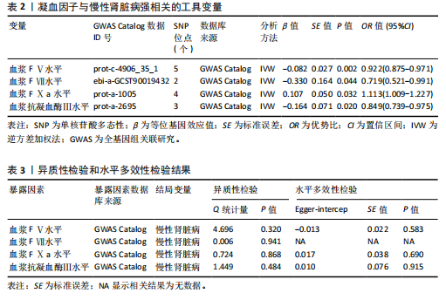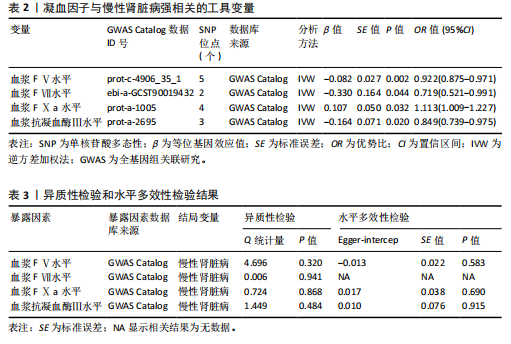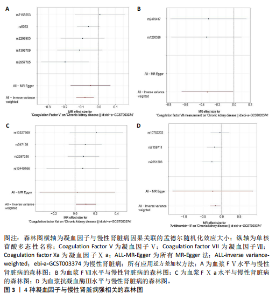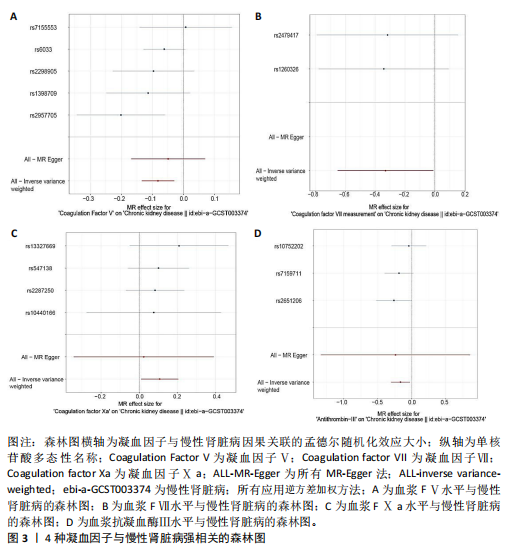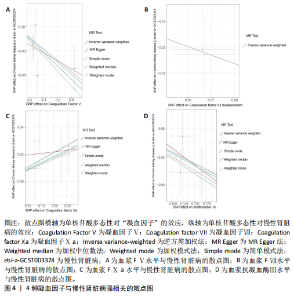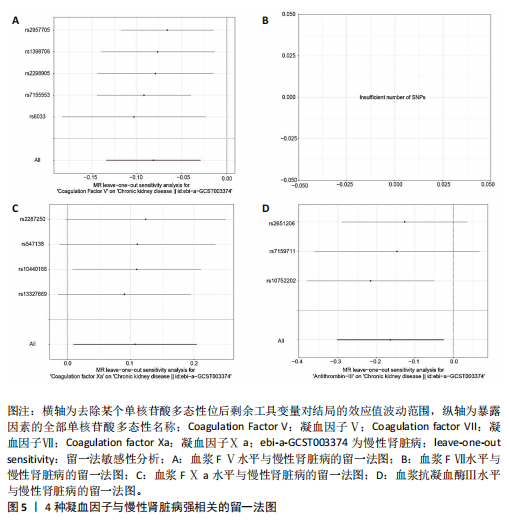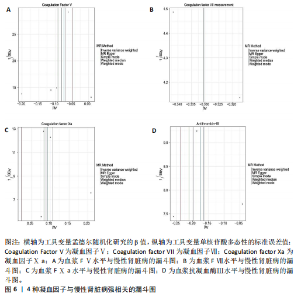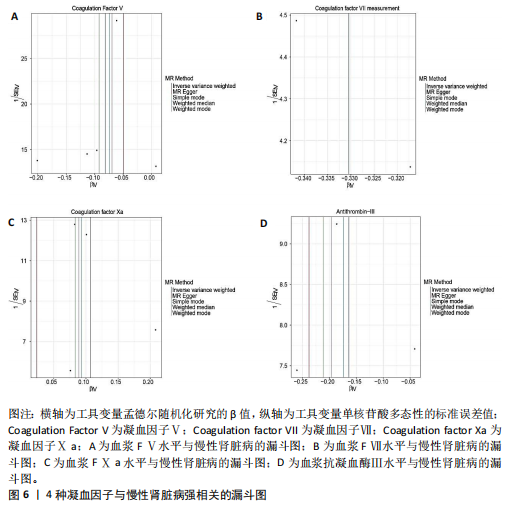Chinese Journal of Tissue Engineering Research ›› 2025, Vol. 29 ›› Issue (24): 5272-5280.doi: 10.12307/2025.733
Causal relationship between 39 plasma coagulation factors and chronic kidney disease based on samples from the GWAS Catalog database
Peng Zehong1, Zhu Xi2, Wen Jianglong2, Zhu Wenzhuo1, Liu Chao2, Tang Jianwei1, Cao Ziyue1, Zhu Lili1, 2
- 1Department of Family Medicine, 2Department of Special Services, The Second Affiliated Hospital of Hunan Normal University/the 921st Hospital of the PLA Joint Logistics Support Force, Changsha 410003, Hunan Province, China
-
Received:2024-09-18Accepted:2024-10-28Online:2025-08-28Published:2025-02-06 -
Contact:Zhu Lili, PhD, Professor, Master’s supervisor, Department of Family Medicine, The Second Affiliated Hospital of Hunan Normal University/the 921st Hospital of the PLA Joint Logistics Support Force, Changsha 410003, Hunan Province, China; Department of Special Services, The Second Affiliated Hospital of Hunan Normal University/the 921st Hospital of the PLA Joint Logistics Support Force, Changsha 410003, Hunan Province, China -
About author:Peng Zehong, Master’s candidate, Department of Family Medicine, The Second Affiliated Hospital of Hunan Normal University/the 921st Hospital of the PLA Joint Logistics Support Force, Changsha 410003, Hunan Province, China -
Supported by:Scientific Research Project of Hunan Provincial Department of Education, No. 21C0056 (to ZLL); Postgraduate Research Innovation Project of Hunan Provincial Department of Education, No. CX20230530 (to PZH); Scientific Research Project of Hunan Provincial Department of Education, No. 20C1152 (to LC)
CLC Number:
Cite this article
Peng Zehong, Zhu Xi, Wen Jianglong, Zhu Wenzhuo, Liu Chao, Tang Jianwei, Cao Ziyue, Zhu Lili. Causal relationship between 39 plasma coagulation factors and chronic kidney disease based on samples from the GWAS Catalog database[J]. Chinese Journal of Tissue Engineering Research, 2025, 29(24): 5272-5280.
share this article
Add to citation manager EndNote|Reference Manager|ProCite|BibTeX|RefWorks
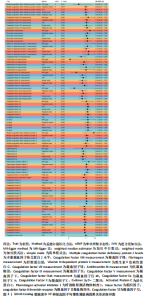
2.1 工具变量的筛选及弱工具变量偏倚的判断 根据GWAS Catalog数据库中ID号的不同,总共发现39种凝血因子表型,并在进行这39种凝血因子对慢性肾脏病影响的孟德尔随机化分析时,根据工具变量筛选条件,筛选出4种凝血因子表型对慢性肾脏病的影响,分别为血浆FⅤ水平、血浆FⅦ水平、血浆FⅩa水平、血浆抗凝血酶Ⅲ水平,并且每种表型分别最终筛选出5,2,4,3个与凝血因子强相关的SNP作为工具变量,见表2。 2.2 凝血因子与慢性肾脏病之间的因果关系 在进行GWAS Catalog数据库中的39种凝血因子表型对慢性肾脏病影响的孟德尔随机化分析中发现,在5种孟德尔随机化分析方法中,ivW作为主要分析方法的结果显示,有4种凝血因子:血浆FⅤ水平(OR=0.922,95%CI:0.875-0.971,P=0.002)、血浆FⅦ水平(OR=0.719,95%CI:0.521-0.991,P=0.044)、血浆FⅩa水平(OR=1.113,95%CI:1.009-1.227,P=0.032)、血浆抗凝血酶Ⅲ水平(OR=0.849,95%CI:0.739-0.975,P=0.020)与慢性肾脏病之间有显著性意义,发现其中凝血因子中血浆FⅩa水平是慢性肾脏病发生风险的危险因素,而血浆FⅤ水平、血浆FⅦ水平、血浆抗凝血酶Ⅲ水平是慢性肾脏病发生风险的保护因素,见图2,3。根据双样本孟德尔随机化分析结果所示,在进行MR-Egger回归、WM、简单模型、加权模型分析时,由于血浆FⅦ水平强相关的SNP只有2个,强相关的SNP不足以进行MR-Egger回归、加权中位数、简单模型、加权模型分析,而血浆FⅤ水平、血浆FⅩa水平、血浆抗凝血酶Ⅲ水平进行MR-Egger回归、加权中位数、简单模型及加权模型分析的结果与ivW分析结果总的效应值方向是一致的,见表3,图4。 2.3 凝血因子对慢性肾脏病影响的敏感性分析 2.3.1 异质性和水平多效性分析 在进行GWAS Catalog数据库中的39种凝血因子对慢性肾脏病影响的孟德尔随机化分析中,通过使用ivW方法进行异质性检测分析,Cochran′s Q检验结果表明,有4种凝血因子表型:血浆FⅤ水平、血浆FⅦ水平、血浆FⅩa水平、血浆抗凝血酶Ⅲ水平,对慢性肾脏病的工具变量中均不存在异质性(P > 0.05)。在进行MR-Egger回归的截距项来分析SNP的水平多效性时,血浆FⅤ水平、血浆FⅩa水平、血浆抗凝血酶Ⅲ水平分别对慢性肾脏病的工具变量中均不存在水平多效性(P > 0.05),但是由于血浆FⅦ水平与慢性肾脏病之间强相关的SNP只有2个,强相关的SNP太少,所以无法进行水平多效性检验,Egger-intercep值、SE值、P值显示结果为无,见表3。 2.3.2 留一法敏感性分析结果 通过leave-one-out敏感性分析法对结果进行评估,逐一剔除所选SNP,并对其是否影响总体因果关系进行分析,血浆FⅤ水平、血浆FⅩa水平、血浆抗凝血酶Ⅲ水平与慢性肾脏病之间的留一法分析结果显示,均未出现影响总体因果关系显著变化的SNP位点,但是由于血浆FⅦ水平与慢性肾脏病之间强相关的SNP太少,所以无法进行留一法敏感性分析,另外,分别从血浆FⅤ水平、血浆FⅩa水平、血浆抗凝血酶Ⅲ水平与慢性肾脏病之间的漏"
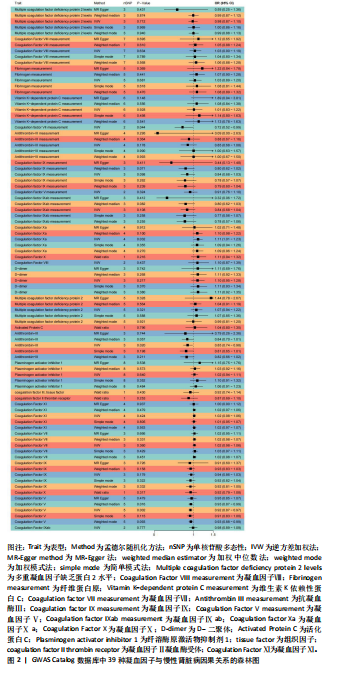
| [1] AMMIRATI AL. Chronic kidney disease. rev assoc med bras (1992). 2020;66Suppl 1 (Suppl 1):s03-s09. [2] KIDNEY DISEASE: IMPROVING GLOBAL OUTCOMES (KDIGO) CKD WORK GROUP. KDIGO 2024. Clinical practice guideline for the evaluation and management of chronic kidney disease. Kidney Int. 2024; 105(4S):S117-S314. [3] CHEN TK, KNICELY DH, GRAMS ME. Chronic kidney disease diagnosis and management: a review. JAMA. 2019;322(13):1294-1304. [4] ADDI T, DOU L, BURTEY S. Tryptophan-derived uremic toxins and thrombosis in chronic kidney disease. Toxins (Basel). 2018;10(10):412. [5] PARIKH AM, SPENCER FA, LESSARD D, et al. Venous thromboembolism in patients with reduced estimated GFR: a population-based perspective. Am J Kidney Dis. 2011; 58(5):746-755. [6] PAVORD S, MYERS B. Bleeding and thrombotic complications of kidney disease. Blood Rev. 2011;25(6):271-278. [7] JALAL DI, CHONCHOL M, TARGHER G. Disorders of hemostasis associated with chronic kidney disease. Semin Thromb Hemost. 2010;36(1):34-40. [8] WEINER DE, TIGHIOUART H, ELSAYED EF, et al. The relationship between nontraditional risk factors and outcomes in individuals with stage 3 to 4 CKD. Am J Kidney Dis. 2008;51(2):212-223. [9] ZHAO J, ZHOU SQ, CHEN YX, et al. Causal relationship between mitochondrial-associated proteins and sepsis in ICU patients: a mendelian randomization study. ACS Omega. 2024;9(7):8457-8463. [10] ZHANG T, CHEN H, SHI Y, et al. Mitochondrial biological function and risk of atrial fibrillation and atrial flutter: a 2-sample Mendelian randomization study. Medicine (Baltimore). 2024;103(27):e38631. [11] LAWLOR DA, HARBORD RM, STERNE JA, et al. Mendelian randomization: using genes as instruments for making causal inferences in epidemiology. Stat Med. 2008;27(8):1133-1163. [12] LIU H, ZHANG Y, ZHANG H, et al. Effect of plasma vitamin C levels on Parkinson’s disease and age at onset: a Mendelian randomization study. J Transl Med. 2021; 19(1):221. [13] YANG H, SHI P, LI M, et al. Mendelian-randomization study reveals causal relationships between nitrogen dioxide and gut microbiota. Ecotoxicol Environ Saf. 2023;267:115660. [14] DUNBAR JK, CAMPBELL H. Genetic epidemiology. J R Coll Physicians Edinb. 2012;42(2):139-141; quiz 142. [15] WALSH R, JURGENS SJ, ERDMANN J, et al. Genome-wide association studies of cardiovascular disease. Physiol Rev. 2023; 103(3):2039-2055. [16] ARDISSINO M, MORLEY AP, SLOB E, et al. Birth weight influences cardiac structure, function, and disease risk: evidence of a causal association. Eur Heart J. 2024; 45(6):443-454. [17] FENG R, LU M, XU J, et al. Pulmonary embolism and 529 human blood metabolites: genetic correlation and two-sample Mendelian randomization study. BMC Genom Data. 2022;23(1):69. [18] NGUYEN K, MITCHELL BD. A guide to understanding mendelian randomization studies. Arthritis Care Res (Hoboken). 2024; 76(11):1451-1460. [19] XU R, LIU S, LI LY, et al. Causal effects of gut microbiota on the risk of erectile dysfunction: a Mendelian randomization study. Int J Impot Res. 2024. doi: 10.1038/s41443-024-00824-7. [20] JING S, LIN L, LI J, et al. Causal relationship between Helicobacter pylori infection and IgA nephropathy: a bidirectional two-sample mendelian randomization study. Ren Fail. 2024;46(2):2371055. [21] LIU X, QI X, HAN R, et al. Gut microbiota causally affects cholelithiasis: a two-sample Mendelian randomization study. Front Cell Infect Microbiol. 2023;13:1253447. [22] BURGESS S, THOMPSON SG. Interpreting findings from Mendelian randomization using the MR-Egger method. Eur J Epidemiol. 2017;32(5):377-389. [23] VERBANCK M, CHEN CY, NEALE B, et al. Detection of widespread horizontal pleiotropy in causal relationships inferred from Mendelian randomization between complex traits and diseases. Nat Genet. 2018;50(5):693-698. [24] LIU G, ZHAO Y, JIN S, et al. Circulating vitamin E levels and Alzheimer’s disease: a Mendelian randomization study. Neurobiol Aging. 2018;72:189.e1-189.e9. [25] WANG S, WANG J, NIU Z, et al. Causal relationship between mitochondrial-associated proteins and cerebral aneurysms: a Mendelian randomization study. Front Neurol. 2024;15:1405086. [26] YUAN S, MASON AM, TITOVA OE, et al. Morning chronotype and digestive tract cancers: Mendelian randomization study. Int J Cancer. 2023;152(4):697-704. [27] SKRIVANKOVA VW, RICHMOND RC, WOOLF B, et al. Strengthening the reporting of observational studies in epidemiology using mendelian randomization: the STROBE-MR statement. JAMA. 2021;326(16):1614-1621. [28] WU F, HUANG Y, HU J, et al. Mendelian randomization study of inflammatory bowel disease and bone mineral density. BMC Med. 2020;18(1):312. [29] NABER T, PUROHIT S. Chronic kidney disease: role of diet for a reduction in the severity of the disease. Nutrients. 2021; 13(9):3277. [30] JONES A, SWAN D, LISMAN T, et al. Anticoagulation in chronic kidney disease: current status and future perspectives. J Thromb Haemost. 2024;22(2):323-336. [31] MUSLIMOVIC A, RASIC S, TULUMOVIC D, et al. Inflammatory markers and procoagulants in chronic renal disease stages 1-4. Med Arch. 2015;69(5):307-310. [32] HUANG MJ, WEI RB, WANG Y, et al. Blood coagulation system in patients with chronic kidney disease: a prospective observational study. BMJ Open. 2017;7(5):e014294. [33] PANOUTSOPOULOU K, WHEELER E. Key concepts in genetic epidemiology. Methods Mol Biol. 2018;1793:7-24. [34] DAVEY SMITH G, HEMANI G. Mendelian randomization: genetic anchors for causal inference in epidemiological studies. Hum Mol Genet. 2014;23(R1):R89-R98. [35] WATTANAKIT K, CUSHMAN M, STEHMAN-BREEN C, et al. Chronic kidney disease increases risk for venous thromboembolism. J Am Soc Nephrol. 2008;19(1):135-140. [36] MAST AE, RUF W. Regulation of coagulation by tissue factor pathway inhibitor: Implications for hemophilia therapy. J Thromb Haemost. 2022;20(6):1290-1300. [37] YAU JW, TEOH H, VERMA S. Endothelial cell control of thrombosis. BMC Cardiovasc Disord. 2015;15:130. [38] JOURDE-CHICHE N, DOU L, SABATIER F, et al. Levels of circulating endothelial progenitor cells are related to uremic toxins and vascular injury in hemodialysis patients. J Thromb Haemost. 2009;7(9):1576-1584. [39] CHEN TY, LIN TT, HSIEH MY, et al. Circulating progenitor cells affect thrombosis of dialysis arteriovenous fistulas. Am J Nephrol. 2016; 44(6):428-438. [40] YISIREYILI M, SAITO S, ABUDUREYIMU S, et al. Indoxyl sulfate-induced activation of (pro)renin receptor promotes cell proliferation and tissue factor expression in vascular smooth muscle cells. PLoS One. 2014;9(10):e109268. [41] ONO T. Roles of coagulation pathway and factor Xa in chronic kidney disease (CKD). Yakugaku Zasshi. 2012;132(4):449-453. [42] AHNSTRöM J. FV/FVa revealed. Blood. 2021;137(22):3011-3013. [43] LI Y, LIU H, YE S, et al. The effects of coagulation factors on the risk of endometriosis: a Mendelian randomization study. BMC Med. 2023;21(1):195. [44] YUAN S, BRUZELIUS M, DAMRAUER SM, et al. Cardiometabolic, lifestyle, and nutritional factors in relation to varicose veins: a mendelian randomization study. J Am Heart Assoc. 2021;10(21):e022286. [45] HOU Y, XIAO Z, ZHU Y, et al. Blood metabolites and chronic kidney disease: a Mendelian randomization study. BMC Med Genomics. 2024;17(1):147. [46] ZHAO Y, HU Y, SMITH JP, et al. Cohort profile: the China Health and Retirement Longitudinal Study (CHARLS). Int J Epidemiol. 2014;43(1):61-68. [47] CNCB-NGDC MEMBERS AND PARTNERS. Database resources of the national genomics data center, china national center for bioinformation in 2024. Nucleic Acids Res. 2024;52(D1):D18-D32. |
| [1] | Zeng Hao, Sun Pengcheng, Chai Yuan, Huang Yourong, Zhang Chi, Zhang Xiaoyun. Association between thyroid function and osteoporosis: genome-wide data analysis of European populations [J]. Chinese Journal of Tissue Engineering Research, 2026, 30(4): 1019-1027. |
| [2] | Rong Xiangbin, , Zheng Haibo, Mo Xueshen, Hou Kun, Zeng Ping, . Plasma metabolites, immune cells, and hip osteoarthritis: causal inference based on GWAS data from European populations [J]. Chinese Journal of Tissue Engineering Research, 2026, 30(4): 1028-1035. |
| [3] | He Qiwang, , , Chen Bo, Liang Fuchao, Kang Zewei, Zhou Yuan, Ji Anxu, Tang Xialin, . Relationship between Alzheimer’s disease and sarcopenia and body mass index: analysis of GWAS datasets for European populations [J]. Chinese Journal of Tissue Engineering Research, 2026, 30(4): 1036-1046. |
| [4] | Ding Yu, Chen Jingwen, Chen Xiuyan, Shi Huimin, Yang Yudie, Zhou Meiqi, Cui Shuai, . Circulating inflammatory proteins and myocardial hypertrophy: large sample analysis of European populations from GWAS Catalog and FinnGen databases [J]. Chinese Journal of Tissue Engineering Research, 2026, 30(4): 1047-1057. |
| [5] | Chen Jiayong, Tang Meiling, Lu Jianqi, Pang Yan, Yang Shangbing, Mao Meiling, Luo Wenkuan, Lu Wei, Zhou Jiatan. Based on Mendelian randomization, the causal relationship between 1400 metabolites and sarcopenia and the correlation analysis of cardiovascular disease were investigated [J]. Chinese Journal of Tissue Engineering Research, 2025, 29(在线): 1-11. |
| [6] | Zhang Yibo, Lu Jianqi, Mao Meiling, Pang Yan, Dong Li, Yang Shangbing, Xiao Xiang. Exploring the causal relationship between rheumatoid arthritis and coronary atherosclerosis: a Mendel randomized study involving serum metabolites and inflammatory factors [J]. Chinese Journal of Tissue Engineering Research, 2025, 29(在线): 1-9. |
| [7] | Dong Tingting, Chen Tianxin, Li Yan, Zhang Sheng, Zhang Lei. Causal relationship between modifiable factors and joint sports injuries [J]. Chinese Journal of Tissue Engineering Research, 2025, 29(9): 1953-1962. |
| [8] | Chen Shuai, Jin Jie, Han Huawei, Tian Ningsheng, Li Zhiwei . Causal relationship between circulating inflammatory cytokines and bone mineral density based on two-sample Mendelian randomization [J]. Chinese Journal of Tissue Engineering Research, 2025, 29(8): 1556-1564. |
| [9] |
Zhao Wensheng, Li Xiaolin, Peng Changhua, Deng Jia, Sheng Hao, Chen Hongwei, Zhang Chaoju, He Chuan.
Gut microbiota and osteoporotic fractures #br#
#br#
[J]. Chinese Journal of Tissue Engineering Research, 2025, 29(6): 1296-1304.
|
| [10] | Ma Haoyu, Qiao Hongchao, Hao Qianqian, Shi Dongbo. Causal effects of different exercise intensities on the risk of osteoarthritis [J]. Chinese Journal of Tissue Engineering Research, 2025, 29(6): 1305-1311. |
| [11] | Li Jiatong, Jin Yue, Liu Runjia, Song Bowen, Zhu Xiaoqian, Li Nianhu . Association between thyroid function levels and phenotypes associated with sarcopenia [J]. Chinese Journal of Tissue Engineering Research, 2025, 29(6): 1312-1320. |
| [12] | Wu Guangtao, Qin Gang, He Kaiyi, Fan Yidong, Li Weicai, Zhu Baogang, Cao Ying . Causal relationship between immune cells and knee osteoarthritis: a two-sample bi-directional Mendelian randomization analysis [J]. Chinese Journal of Tissue Engineering Research, 2025, 29(5): 1081-1090. |
| [13] | Wang Xuepeng, , He Yong, . Effect of insulin-like growth factor family member levels on inflammatory arthritis: a FinnGen biobank-based analysis [J]. Chinese Journal of Tissue Engineering Research, 2025, 29(35): 7656-7662. |
| [14] | Wang Tao, Wang Shunpu, Min Youjiang, Wang Min, Li Le, Zhang Chen, Xiao Weiping. Causal relationship between gut microbiota and rheumatoid arthritis: data analysis in European populations based on GWAS data [J]. Chinese Journal of Tissue Engineering Research, 2025, 29(35): 7663-7668. |
| [15] | Han Jie, Pan Chengzhen, Shang Yuzhi, Zhang Chi. Identification of immunodiagnostic biomarkers and drug screening for steroid-induced osteonecrosis of the femoral head [J]. Chinese Journal of Tissue Engineering Research, 2025, 29(35): 7690-7700. |
| Viewed | ||||||
|
Full text |
|
|||||
|
Abstract |
|
|||||
